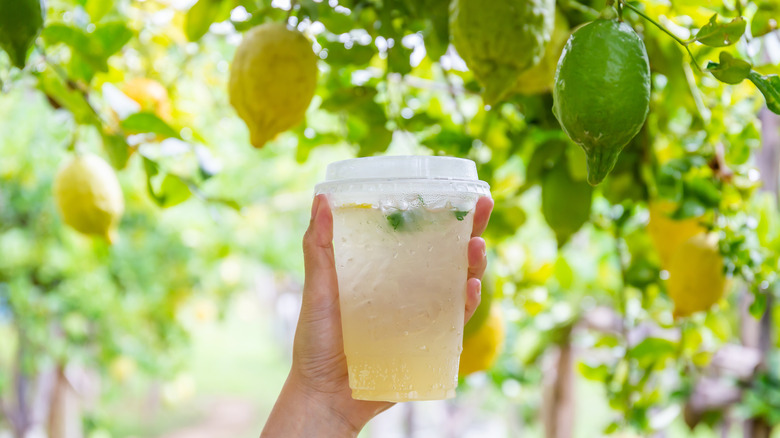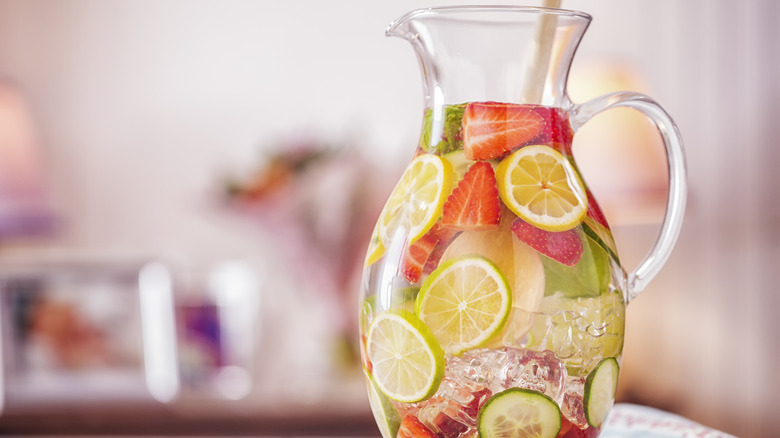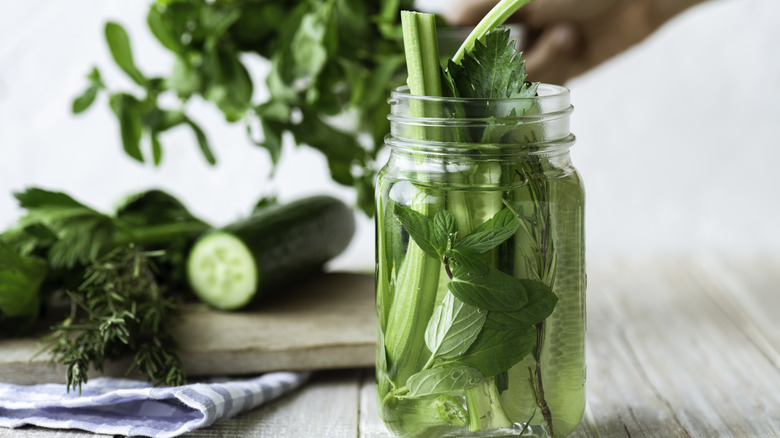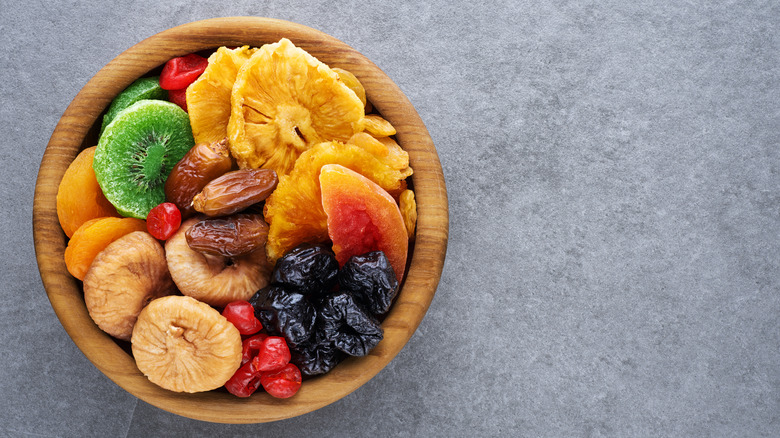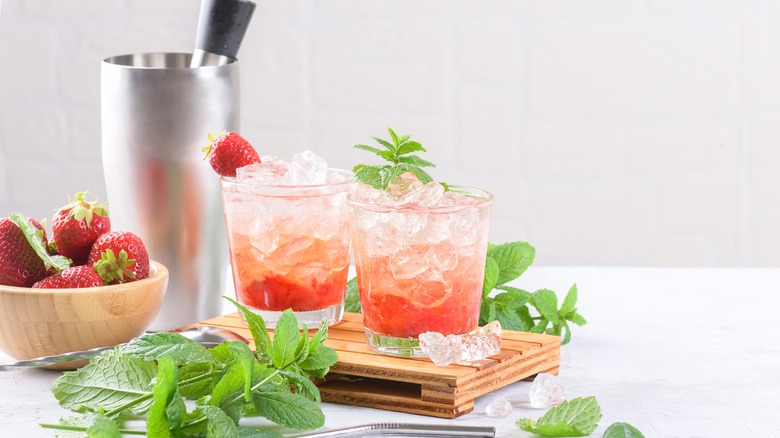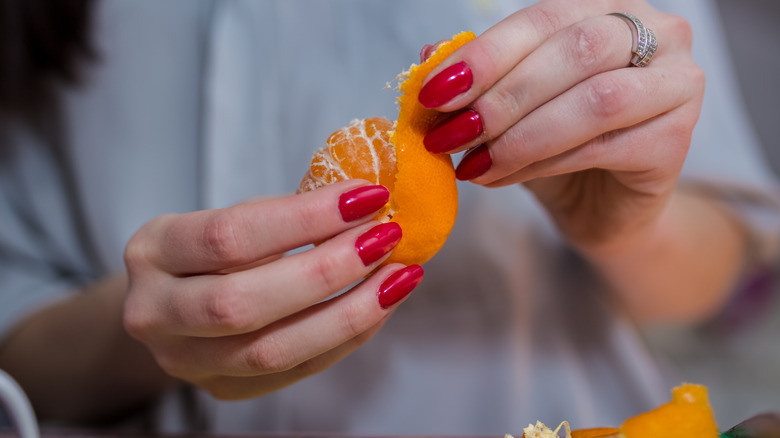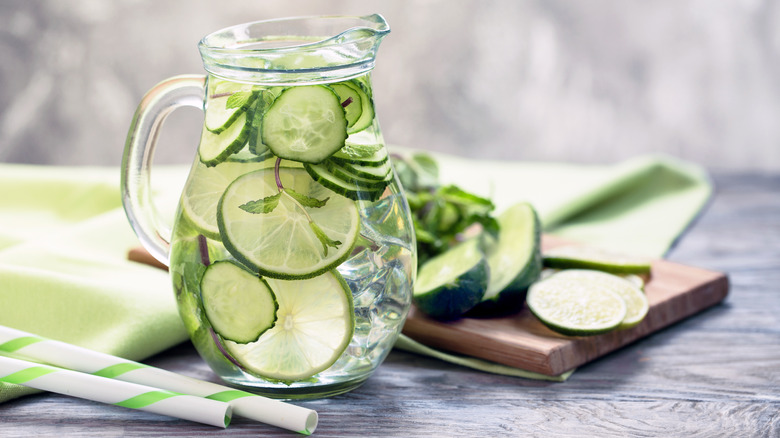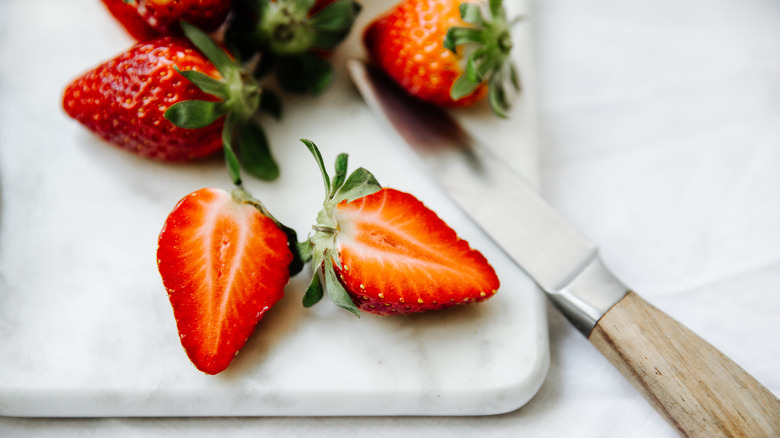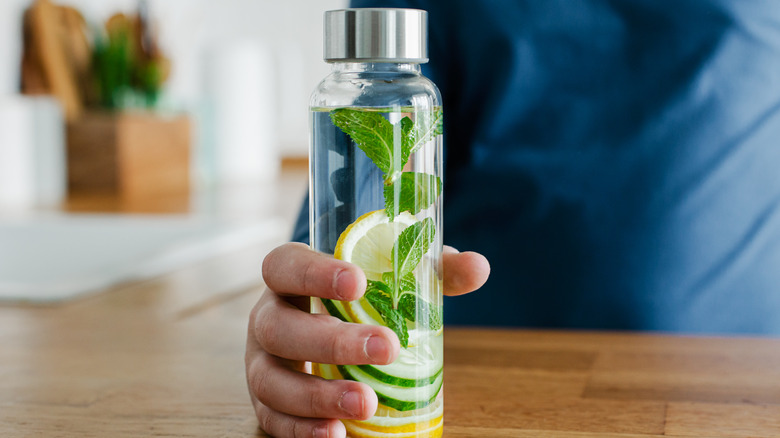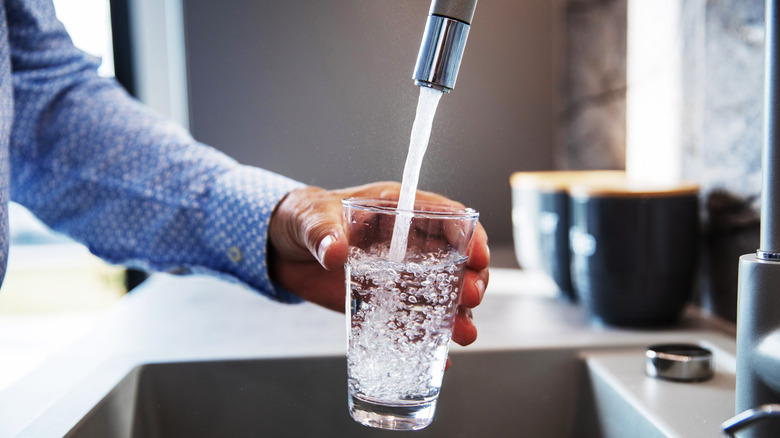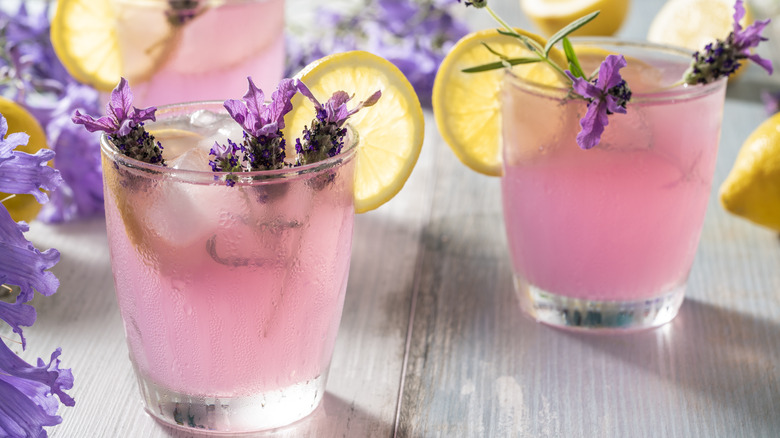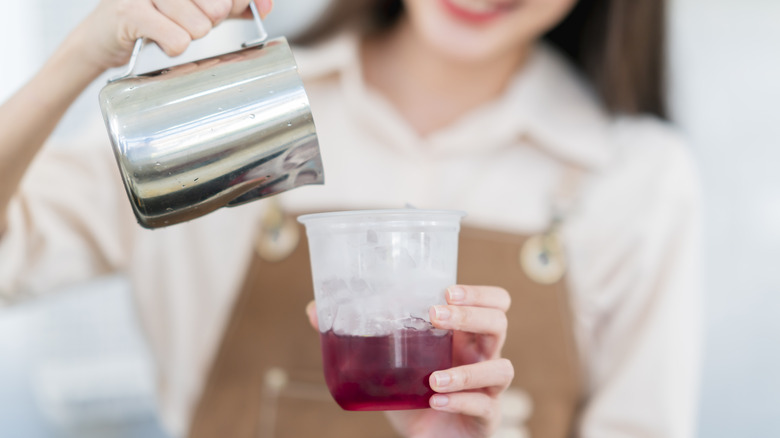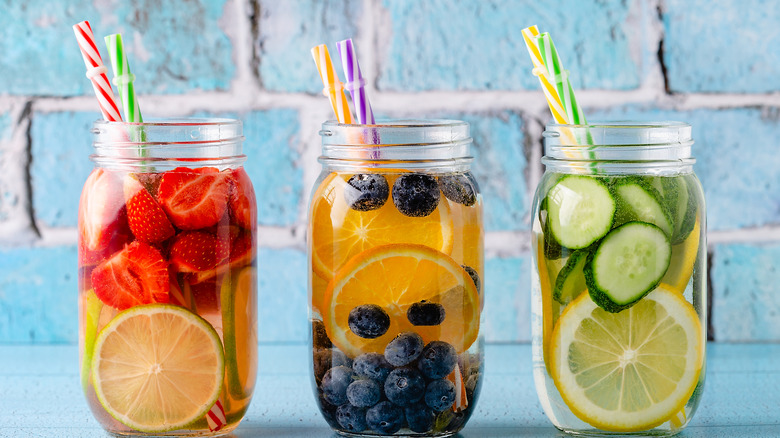Mistakes Everyone Makes When Infusing Water
If you've never infused your water before, you don't know what you're missing. Not only is it void of icky artificial sweeteners, flavors, and colors, but it also contains zero grams of added sugar, yet packs more flavor than you'd ever expect. And while the process of infusing water isn't a complex one, it requires attention to detail if you want it done right. We'll explore some of the ways you can up the ante on infused water to take this steeped beverage from average to awesome. By implementing just a few strategies and tips, you'll be on your way to making an infused water so delicious it'll likely have you whipping up a batch multiple times a week.
Ready to learn more about how to make this popular homemade-infused drink so much more amazing? Stick around because we've got some amazingly refreshing tips for you to keep your infused water from going south in a hurry. Strap on your flavor flippers, because we're about to take a refreshing plunge into the world of infused water perfection!
Assuming infusion times will always be the same
The kinds of fruits, veggies, and herbs you use to infuse water will greatly affect your infusion results if you aren't acutely aware of the infusion time for each. Softer fruits like mango, cucumber, and watermelon require less infusion time because of their porous nature. Harder fruit, as you might expect, would take more time, sometimes upwards of 12-18 hours or more to fully infuse flavors.
Still, other kinds of fruit, such as lemon, lime, and strong citrus fruits, may require even less time given their already potent taste (about 2-3 hours). In fact, just slipping a lemon or lime wedge into your drink can infuse the water with a strong citrus flavor in a matter of minutes. Because of this, it's important that you watch how long you infuse fruits and veggies in order to avoid under-infusing or over-infusing your water. As a rule of thumb, only strive to infuse water for a few hours or overnight, especially for the softer or citrusy fruits we discussed. You may need to do a taste test along the way to ensure you're getting the results you need; just be sure not to continue to infuse water for more than 24 hours.
Forgetting to use herbs and veggies
As mentioned, you can totally use herbs and vegetables as a part of your infusing routine. Unconventional as it may sound, vegetables like celery and herbs like basil have the uncanny ability to infuse both fruity and fresh detox drinks with their own captivating depth of flavor.
When infusing, feel free to mix and match your flavors to create wonderfully imaginative creations of your own. Herbs like lavender and basil tend to meld very well with lemon while celery, lemon, mint, and cucumber can yield a concoction so refreshing it'll leave you wondering why you hadn't tried it sooner. Yes, it can sound a bit weird to infuse veggies with herbs and fruit, and it may take more time depending on the ingredients you choose. But the flavor pay-off is well worth it, and the extraordinary richness and intricate interplay of tastes are unparalleled. You'll thank us later!
Using dry or frozen fruit
Using dry or frozen fruit may seem like a convenient, cheaper, and effortless option for infusing water. Indeed, frozen fruit may prove better than dried fruit when infusing water; however, the two aren't actually ideal for producing the best-flavored water results possible from home.
Instead, try using fresh fruit when you can. Frozen fruit tends to impart less flavor to your water compared to fresh fruit. This is likely because of the water released upon thawing. Not only does frozen fruit render a less flavorful-infused batch, but it will also leave your water saturated with tiny bits of fruit floating about, making the water appear murky and unsightly, potentially even after straining.
As for dried fruit, we recommend you avoid it at all costs. It simply does not render the same results as fresh fruit, though you may get subtle hints of flavor in your water here and there depending on the type of dried fruit you use. Ultimately, the best pick for infused water is fresh fruit. It releases the most potent amount of flavor to the water without releasing as many bits and pieces as frozen fruit.
Ignoring the importance of water temperature
How important is water temperature when infusing? Honestly, it can make all the difference in the world! With this in mind, you'll need to be careful when considering the temperature your water will be when infusing. Allow us to explain why. The warmer the water you use, the faster you'll impart flavor to your water. But this isn't the only factor to consider. Using hot water may work to decompose the fruit, herbs, or veggies, and may sometimes even obliterate certain nutrients that are sensitive to heat. Thus, though the flavor of your drink will be strong using this warm or hot water, it may not be as advantageous if you want something that'll benefit your body to the max.
Making your water cold or keeping it in the fridge is advised; however, keep in mind that the infusion process will be much slower. Still, this is a nifty way to keep those much-desired nutrients intact, while also keeping your water safe to drink for as long as possible. Try to keep room temperature steep times to a minimum, to no more than 4 hours on the countertop before transferring and keeping the water in the fridge in order to keep it safe to drink (via North Carolina State University).
Not removing the rinds from citrus fruit
Did you know that keeping the rind on your citrus fruit may result in an altered infusion flavor? Trust us, the results aren't pretty. Though you may be accustomed to throwing a lemon or lime slice in your water, the truth is that doing so for infusion purposes may lead to a bitter end. This is mostly because the rind has a flavor all its own, which usually isn't so pleasant when used for infusion purposes.
Instead, try peeling the rind from your citrus fruits before submerging them into water. Fruits like oranges, limes, lemons, and grapefruits are all examples of fruits whose rinds you'll want to remove before infusing. Once the rind is removed, take the flesh of the fruit, and infuse it into the water. You'll still want to check the water for taste within a few hours as mentioned before, since citrus fruit tends to have a stronger flavor. The results should yield a bright and refreshing sip without a hint of bitterness in sight.
Not removing fruit and veggies after infusion
Once your water has fully infused, it's important that you remove the fruit from the water. By keeping your fruit in the water for too long, you encourage more bacterial growth as the fruit begins to decompose (via Foods Guy). Not only could this yield a threat to your health, but it can also affect the way your water tastes over time.
In addition, your freshly infused water will suffer aesthetically if you choose to leave your fruit pieces in after infusing. As the fruit starts to break down, it will leave tiny bits of whatever ingredients you've used floating within the drink. This will be worse if you use frozen fruit, but can happen with fresh fruit, too, especially softer ones. Thus, it's important to always remove the fruit, herbs, or veggies after infusion. Want to decorate your water with a bit of those ingredients? No problem! Simply chop up some fresh fruit, veggies, and herbs, and toss them in before serving. It'll look prettier, and the awesome part is that your water will still taste great.
Keeping the infused water for too long
Infused water is just water, right? Shouldn't it keep indefinitely if stored in the fridge? Well, not quite. Though your water isn't likely to spoil the way that meat, cheese, or dairy would, it definitely isn't as long-lasting as you may think once you've added fresh ingredients to the mix. At most, it's recommended that you keep your infused water for three days.
Why? It's the addition of ingredients to your water that can make it susceptible to bacterial growth, even in the fridge (via North Carolina State University). Store-bought flavored waters tend to come with preservatives and packaging methods to help maintain their shelf life, but water made at home will (thankfully) contain no such thing. As a result, you'll need to be mindful of the amount of time you keep your steeped water, and be diligent to pitch it after the fill three days have passed.
Whatever you do, never store your water longer than three days with fruit, veggies, or herbs still in it. As mentioned before, infusion times may vary, but they should typically never exceed 24 hours. After infusion, the fruit is to be strained and the water stored in the fridge. If you're using fresh fruits and veggies to dress up the water, you should also remove these before refrigerating the drink long-term, since these will eventually decompose (and even change the taste of your water) over time.
Forgetting to slice (most) fruits
In general, slicing fruit and veggies before placing them in water can be an awesome way to get the most bang for your buck in terms of flavor. The exposing of the flesh, which contains most of that juicy flavor, can help impart tasty deliciousness easier to your water than a whole fruit would. Not only this, but it will enable you to fit bigger fruits in your pitcher or water bottle much easier.
There are times, however, when this won't prove a necessary step to take. When using certain berries, for example, you may not need to slice the fruit to achieve full flavor. Some berries tend to be exceedingly tiny anyway, so chopping them beforehand will only lead to mess and stress. A good example of berries not to chop include blueberries and raspberries. Strawberries, on the other hand, may benefit from slicing before placing them in water for infusion. All other fruits should be sliced or chopped for maximum infusion of flavors. Yum!
Purchasing expensive infusion water bottles
Isn't it just like certain manufacturing companies to capitalize on something that's already so simple? Infusing water is one of those things that manufacturers have figured out they could make a little moolah on, but it isn't necessarily to your benefit. Although infusion water bottles may come across as nifty and sport a cool appearance, they are, in all honesty, entirely superfluous. Why? You really only need a single pitcher to whip up a quick batch of infused water. Once infused, you just need to put it into a regular water bottle, and you're good to go.
Now, we know what you're thinking. What if you're on the go and don't have time to wait for the infusion process? We agree that's a great point; however, it also overlooks the fact that the water infusion process is time sensitive. So, if you add fruit to your water and start sipping an hour later, the flavor won't be as strong as it would've been had you let it sit in a pitcher overnight. Likewise, if you let your fruit sit in your water bottle for longer than need be, you'll end up with an unbearably strong drink, especially if you used citrus fruits.
Because of these insights, we highly discourage you from using infusion water bottles. It isn't as effective as you might think, and may even lead to over or under-flavored water, depending on how long you wait before you sip it.
Using water that already has a strong aftertaste
The type of water you choose to use for the infusion process is fairly important in regard to how your water will taste in the end. As you might imagine, using water that is already bitter, peculiar, or oddly tasting will have a negative effect on your infused water, hindering its potential for pure refreshment. By imparting unwanted flavor, your water may not turn out as hoped, and you'll have ended up wasting your fresh fruit, veggies, and herbs on something you may not like in the first place.
Instead, try using distilled or filtered water before starting the infusion process. These waters tend to be cleaner and fresher tasting, thus providing an excellent base that allows your infused fruit, herbs, and veggies to shine. Tap water and well water can sometimes impart icky flavors to your water that may prevent you from clearly tasting the nuances of the ingredients you chose. If you don't have distilled or filtered water, spring water may also work, although you'll need to already be accustomed to the flavor of spring water; its natural minerals can sometimes give it a distinct taste of its own.
Forgetting to experiment
Remember that the world is your oyster here when it comes to all the cool flavor combinations you can come up with to make your own infused water. We've seen tons of interesting flavored water combinations out there from apple and carrot to cucumber, mint, and jalapeño flavors.
So, what are some of the more interesting ingredients you can use in your infused water? Try on herbs for size! For example, thyme sprigs can provide a beautiful hint of something different to your lemon-infused water as can a bit of basil or oregano. If you're really feeling adventurous, try adding a bit of hibiscus with orange, and a touch of cinnamon or clove for a uniquely spicy yet floral rendition of infused water.
Speaking of florals, did you know that some types of petals may prove delicious in finished water? Try lavender or petals from roses (pesticide-free, please) and combine them with lemon, raspberry, or strawberry flavors. This would also meld beautifully with watermelon and mint infusions. Whatever your desire, make sure to get creative when choosing which ingredients to use. It'll make all the difference in the subtlety of flavor, and will keep things interesting to boot.
Using the same fruits and veggies twice
Now, this one might be a bit controversial among those who really want to minimize waste, but honestly, reusing the same fruit for different batches can lead to weaker water infusion. While it's totally fine and even admirable if you would rather reuse the same fruits, veggies, and herbs for multiple batches, it may not be in your best interest, especially if you are going for longer steeping times.
When you reuse the fruit, veggies, and herbs for your infused beverage, you're ultimately not going to get a potent result the second and third time around. And this makes sense, right? As the first steeping process ensues, you're essentially extracting all the flavor and goodness out of your ingredients right from the very start. This is especially true of softer, more porous fruits and veggies, especially if you steep them for a long time. Conversely, using the same ingredients, although more economical, will produce only a hint of flavor rather than a full-on infusion. So, it's often best to simply start with a new batch of fresh fruit, herbs, and veggies for each infusion for ultimate tasty results.
Not eating the leftover fruits and veggies after infusion
Remember how we told you that you should remove fruit from water infusions within 24 hours of starting the steeping process? This doesn't mean the fruit has to go to waste! Though you probably shouldn't continue to use it for infusing (though you could if you don't mind a weaker taste), your very best choice is to go right ahead and eat the fruit as is.
Yep, that's right. You can pop the fruit in your mouth and go about your day. Rest assured, there's absolutely nothing harmful about indulging in fruit infused in water, as long as you've faithfully followed our time recommendations for infusing in the first place. Alternatively, feel free to throw your leftover fruit into a blender with a banana and yogurt for a delicious-tasting smoothie, or use it to blend with milk to yield the perfect fruit-flavored liquid for cooking up a pot of fresh morning oatmeal. No matter how you use it, just know that your fruit used for water infusion definitely doesn't need to go in the trash. As long as it only steeps for 24 hours or less, you're totally safe to eat and enjoy. Just be sure to watch out for potential seeds or fruit pits!
Not using the right fruits and veggies in your water
Now, with all this talk of yummy water-infusing flavor combos, you should know that certain types of fruit and veggies may work better for infusion than others. Of course, this doesn't mean that you absolutely shouldn't use certain fruits and veggies. What it does mean, however, is that you should adjust your expectations, along with steep times, if you choose to use certain veggies and fruits. For example, infusing apples, peaches, and certain berries may take a while. In fact, even after steeping for 12-18 hours or more, you still may only be left with a hint of flavor in your water rather than the powerful essence of fruit other types may yield.
On the other hand, flavors like lemon, lime, orange, and mint tend to quickly yield strong essences that taste wonderfully robust, refreshing, and delightful to the tongue. Ultimately, which ingredients you use is up to you; but you'll certainly get varying results depending on what you choose.
